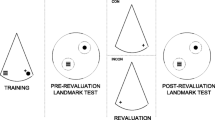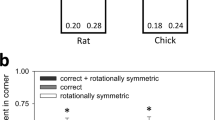Abstract
Three tests investigated how the geometric relation between object/landmarks and goals influenced spatial choice behavior in rats. Two groups searched for hidden food in an object-filled circular arena containing 24 small poles. For the “Proximal” group, four distinct objects in a square configuration were placed close to four baited poles. For the “Distal” group, the identical configuration of objects was rotated 45° relative to the poles containing the hidden food. The Proximal group learned to locate the baited poles more quickly than the Distal group. Tests with removed and rearranged landmarks indicated that the two groups learned to use the objects differently. The results suggested that close proximity of objects to goals encouraged their use as beacons, while greater distance of objects from goals resulted in the global encoding of the geometric properties of the arena and the use of the objects as landmarks.
Similar content being viewed by others
Author information
Authors and Affiliations
Additional information
Received: 22 June 1998 / Accepted after revision: 23 January 1999
Rights and permissions
About this article
Cite this article
Cook, R., Tauro, T. Object-goal positioning influences spatial representation in rats. Anim Cogn 2, 55–62 (1999). https://doi.org/10.1007/s100710050024
Issue Date:
DOI: https://doi.org/10.1007/s100710050024




